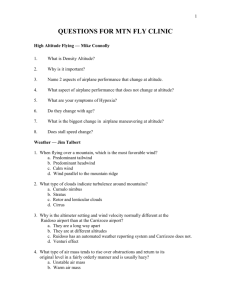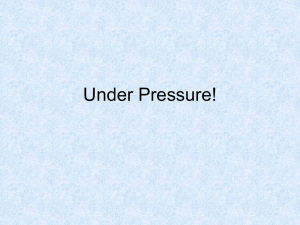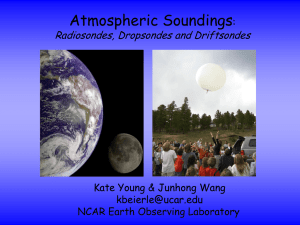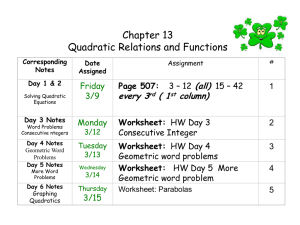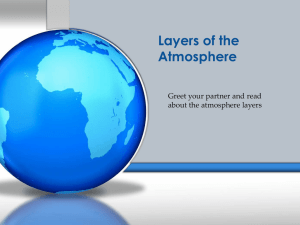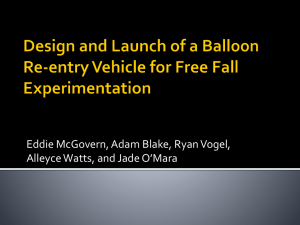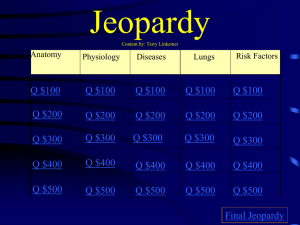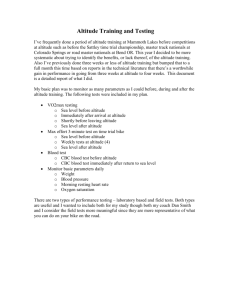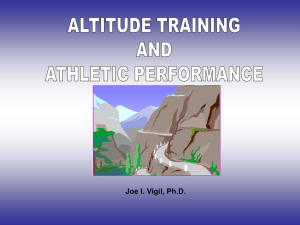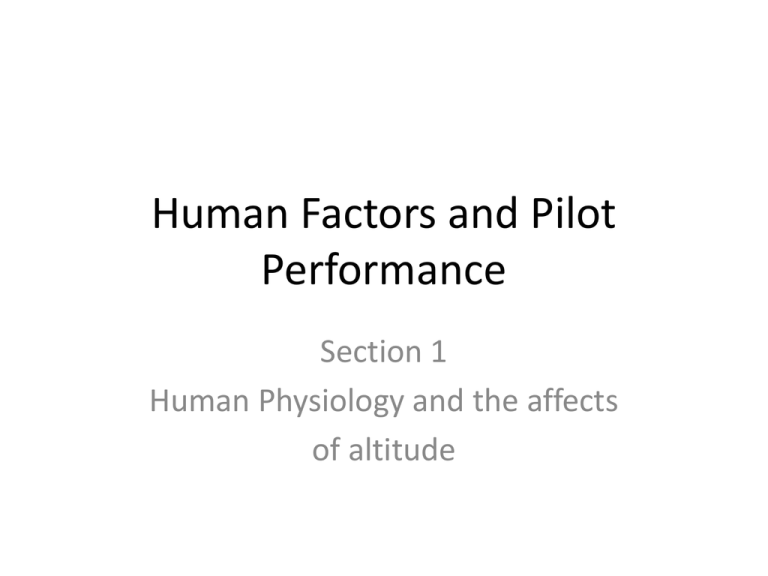
Human Factors and Pilot
Performance
Section 1
Human Physiology and the affects
of altitude
Human Factors and Pilot Performance
• Often shortened to “Human Performance”
• The exam is 30 mins, 16 questions, need to get 12 right
• Quite simple but need to know subject – not more
than 4 answers wrong or FAIL
•
•
•
•
Three sessions/sections
1.Human Physiology and the affects of altitude
2. Seeing, Hearing, Fitness
3. Brain and information processing
• Based on Thom Vol 6. Will refer to specific sections
Human Factors and Pilot Performance
•
•
•
•
•
•
•
•
•
•
•
•
•
1. Human Physiology
1.1. Nervous system Thom Fig 1.1
Central nervous system – brain and spinal cord
Peripheral Nervous system – all nerves running off or to spinal cord
These operate in three different ways:
Autonomic Nervous system – automatic controls – e.g heartbeat, peristalsis,
sweating, blushing
Motor Nervous system – nerves that consciously control muscle movements.
Sensory Nervous system – nerves that send sensations (heat, cold, pain, sound etc)
to the brain, which may send motor signal to appropriate muscles in response. e.g
fight or flight response (run or interact with e.g.
fight/eat/have sex with
More about brain control mechanisms in Section 3.
Human Factors and Pilot Performance
•
1. Human Physiology
•
1.2 Circulatory System (Cardiovascular system)
•
•
•
•
•
•
•
•
Heart – central pump
Arteries – take blood from heart to organs
Veins - bring blood back to heart
•
RED cells transport OXYGEN round the body (HAEMOGLOBIN – iron rich). Used to produce
energy by “burning” sugars in the different muscles and organs.
WHITE cells (many different types) mainly concerned with protection against foreign
substances (VIRUSES, BACTERIA).
PLASMA salty fluid, corpuscles suspended in it.
•
•
) BLOOD
) VESSELS
Note: Pulmonary Artery takes blood from the lungs to the heart
Pulmonary Vein takes blood from the heart to the lungs
Blood – CORPUSCLES , red and white cells.
Human Factors and Pilot Performance
•
1. Human Physiology
•
1.3 BLOOD VESSELS
•
ARTERIES and VEINS are big ones, but these get smaller in the different organs and tissues and end
up as
CAPILLARIES. These make sure there is an efficient blood supply and removal system to organs and
tissues
Simple system above is SYSTEMIC CIRCULATION.
Note: In tissues, where arterial and venous capillaries meet, blood goes from Arteries to Veins
(higher pressure in Arteries)
•
•
•
•
PULMONARY CIRCULATION.
Local circulation of blood to and from the lungs
•
•
•
•
VENOUS (“used”) blood pumped from heart via PULMONARY ARTERY to the lungs,
CARBON DIOXIDE is removed and OXYGEN added
Oxygenated blood returns through the PULMONARY VEIN to the HEART
Then recirculates round the body through the ARTERIES.
Human factors and pilot Performance
•
1. Human Physiology
•
1.4 HEART – see Thom Fig 1.2.
•
•
•
•
Left side of midline, just below breastbone. Contracts as a unit. Pumps blood through non-return
valves. Special groups of muscle cells contract together.
4 chambers 2 each side.
Left – receives venous blood coming back from organs/extremities, pumps it to lungs
Right – receives oxygenated blood from lungs, pumps it into main artery or aorta
•
BLOOD PRESSURE.
•
•
•
•
•
Measure of pressure of blood against walls of the main arteries(elastic)
Highest when heart is contracting (SYSTOLIC pressure)
Lowest when resting (not contracting – DIASTOLIC pressure)
Varies with age. Increases as get older (arteries “ harden” – walls lose elasticity.).
Expressed as mm mercury, systolic/diastolic. Typical normal values are 120/80. Limiting values for
pilots under JAR is160/95 – medically unfit if above this.
Human Factors and Pilot Performance
• 1. Human Physiology
• 1.4 Respiration
• RESPIRATION.
• Brings in oxygen, removes carbon dioxide, according to reaction
below:
• Sugar + oxygen(O2)
carbon dioxide (CO2) + water
• (cells) (blood brings)
(blood takes away)
• This is INTERNAL RESPIRATION
• EXTERNAL RESPIRATION is a continuous process involving lungs,
where CO2 is given out and fresh O2 taken (Thom 1.3)
Human Factors and Pilot Performance
•
1. Human Physiology
•
1.5 Lungs
•
STRUCTURE (Thom 1.3, 1.4)
•
•
•
•
•
In chest cavity, one each side, surrounded by rib cage
Open to atmosphere at top (windpipe)
Muscle across the bottom (diaphragm)
Windpipe divides into increasingly small tubes (bronchii, bronchioles)
These terminate in air sacs (alveoli) which have CAPILLARIES that transport blood
to and from the alveoli
O2 diffuses through alveolus wall into capillary, CO2 goes other way
Both are following concentration gradients
•
•
Human Factors and Pilot Performance
•
•
1. Human Physiology
1.6 BREATHING MECHANISM
•
•
Diaphragm goes down, rib cage (chest cavity) expands
air is drawn IN through the bronchii etc
•
•
Diaphragm goes up, rib cage (chest cavity) contracts
air is forced OUT
•
•
•
Lung capacity ca. 5L but only 0.5 L replaced with each breath.
Small amount of gas exchange due to importance of CO2 in keeping blood pH balance
Therefore amount is kept nearly constant in lungs
•
•
The amount of CO2 in blood varies with muscular activity
To cope with this, breathing rate is controlled by blood CO2 content (higher O2, faster
breathing rate)
Flying and Altitude
• Composition of dry air: 78% nitrogen, 21% oxygen, 1% other
gases (carbon dioxide 0.03%)
• Total air pressure falls with altitude, (approx 1hp/30 ft).
• Relative composition stays constant
• Can have oxygen deficiency at high altitudes
• Additional supply of oxygen essential over 10,000 ft (legal
requirement)
Note: Air also contains variable amounts of water vapour –
varies with temperature and altitude.
Flying and Altitude
LACK OF OXYGEN (HYPOXIA)
• Due to deficient oxygen supply to
brain.
• Onset of symptoms depends of
pilot’s condition as well as
altitude e.g. smoker, unfit, tired
can be as low as 4000ft.
• No smoking in cabin! Be fit! Use
oxygen if necessary!
• May also be caused by inability of
blood to carry enough oxygen
(anaemic hypoxia) which may be
due to carbon monoxide
poisoning (see below)
SYMPTOMS
• False sense of security and
wellbeing
• Faulty judgement
• Clumsiness
• Headache
• Blurred vision
• Rapid pulse
• Blue lips/fingers
Flying and Altitude
Time of Useful Consciousness (TUC)
Affect of sudden failure of oxygen supply
Altitude
22000 ft
25000 ft
28000 ft
30000 ft
35000 ft
40000 ft
Moderate Activity
5 mins
2 mins
1 min
45 secs
30 secs
12 secs
Minimal Activity
10 mins
3 mins
1.5 mins
75 secs
45 secs
15 secs
Flying and Altitude
• Other effects of altitude/flying
Barotrauma
• pain caused by trapped gases
• Gases trapped in your body expand with altitude – stomach,
guts, sinuses, middle ear, decaying tooth.
• Blocked Eustachian tube (links middle ear to back of throat,
discomfort/pain often sensed on descent from high altitudes,
e.g on commercial flight). Due to unequal air pressure on each
side of eardrum. Chewing, swallowing or yawning usually gives
relief.
• Unwise to fly with headcold, sinusitis etc
• Decompression sickness.
• caused by gases dissolved in the blood – pain in joints
• Example: divers, if they surface too rapidly (and/or fly too
soon after diving)
• Dissolved gases released can cause severe pain, especially in
joints (the bends)
• Depends on depth dived to. General rule
• - don’t fly within 12 h of a shallow dive (less than 30ft (10m))
• - don’t fly within 24h (or more) if surfacing from a greater
depth
Flying and Altitude
Carbon monoxide (CO) poisoning.
• Usually from engine exhaust via cabin heating system
• Very dangerous – colourless, tasteless and odourless (but
usually accompanied by other exhaust gases which have
odour e.g. nitrogen oxides)
• Reacts with haemoglobin in blood and prevents oxygen
attaching to it
Flying and Altitude
•
SYMPTOMS of Carbon Monoxide (CO) Poisoning
•
•
•
•
•
•
•
•
•
•
headache etc.
blurred vision
impaired judgement and memory
slower breathing
loss of muscle power
convulsions
coma and death
Note: no blues (lips may turn cherry red)! No euphoria!
Remedy – shut off cabin heat, open fresh air vents/windows, land ASAP
• Useful – have carbon monoxide sensor in cockpit (turns brown if CO
present)
Flying and Altitude
• HYPERVENTILATION.
• Shallow overbreathing – usually due to anxiety
or fear
• often cumulative (anxiety overbreathing
breathlessness greater anxiety etc).
• Due to CO2 balance being upset.
Flying and Altitude
• HYPERVENTILATION Symptoms.
•
•
•
•
•
•
Numbness and tingling of extremities
Palpitations, ringing in ears
Faster pulse
Sweating
Blurred vision
Dizziness/fainting/unconsciousness
•
REMEDY
•
•
•
Slow person down (talk down, reassure)
Breathe into a bag (increases carbon dioxide in blood)
Give person something to do (take mind off whats making them anxious or afraid)
Flying and Altitude
Another altitude affect
• Blocked ears – due to unequal pressure each side of eardrum
(blocked Eustachian tube).
• Often associated with a cold, hayfever, sinusitis etc (variation
on barotrauma) and linked to rapid descent.
REMEDY
Chewing or swallowing usually relieves the pressure, but it will
gradually return to normal anyway

